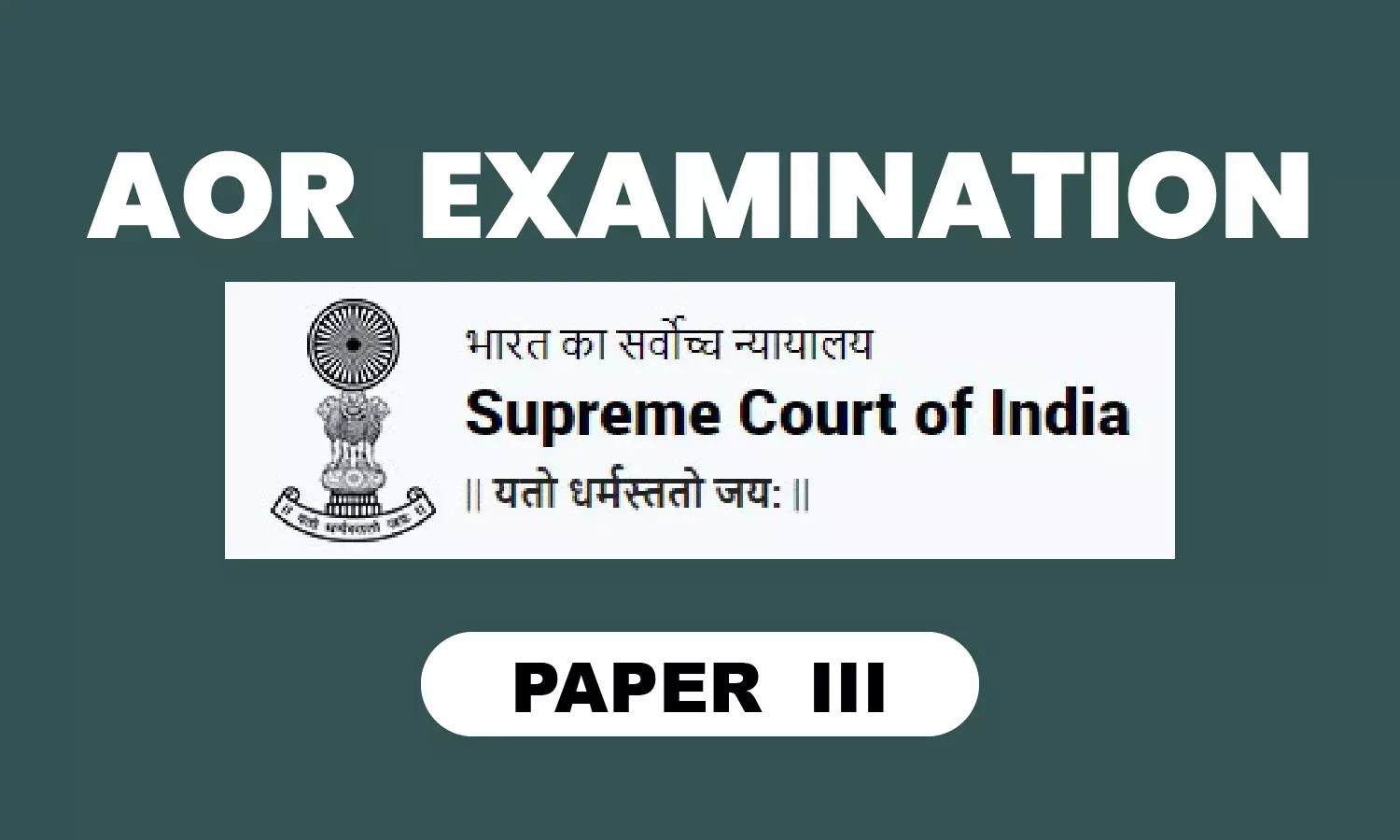Topper’s Answer Script, Sample Handwritten Notes and Guide Points on Paper-III ‘Advocacy & Professional Ethics’ Before Attempting The Advocates-On-Record Examination, 2024
The time now requires moving on to the most relatable paper i.e. Paper-III ‘Advocacy & Professional Ethics’, in fact, in the same sequence which I myself followed during the last attempt, bearing in mind that a good mix of codified material and a bulk of leading cases qua each separate part of the content for the paper would invite reasonably concise but structured preparation. This paper is predominantly based on law created by judicial decisions besides rules framed by the Bar Council of India and notable material on certain topics having interface with practice of law in general, if not with actual practice. The following material consisting of my certified answer script, sample handwritten notes as well as guide points are most likely to aid in the preparation of the current examination.
Lectures by Ld. Senior Advocates organized by the Hon’ble Supreme Court of India.
The Lecture, as delivered by the learned senior advocates, for this attempt, especially by Ms. Kiran Suri, Ld. Senior Advocate, does invite the candidates to capture the hints with respect to the important topics, but unlike the previous attempt wherein detailed description of topics was outlined, the following inputs as culled out must not be lost sight of:
- The important topics revolve around the five (5) parts viz. What is the need of this paper? Advocacy with respect to duties of an advocate towards the client, Professional Ethics with respect to duties of an advocate towards the client, court and colleagues, Special Status of an Advocate-on-Record and Seven Lamps of Advocacy.
- Further, areas such as Advertising, especially through the Website, Strikes by Advocates, Why client is important to the justice delivery system?, Contempt of Court, Privilege Communication, Third Party Advantage by Touts, are also needed to be explored.
- The handwriting should be neat, and one should not attempt the paper in a manner that very detailed answers are written for the first two (2) or three (3) questions, and while later, in exact opposite, very shortly described answers are provided, leading to bad impression before the examiner.
The AoR examination lecture on Paper III by Senior Advocate Rajiv Dutta can be watched here.
Analysis of Past Years’ Question Papers of Advocates-on-Record Examination.
The analysis of past years’ question papers enables one to understand the fact that in most of the previous attempts, questions valuing two (2) marks each have invariably been asked. If one goes by the paper of the last attempt and also of the attempt of December, 2022, it comes clear that short questions valuing four (5) or five (5) marks are the favorites of the examiner(s) and can reasonably be expected to be there in the current examination, besides having descriptive questions valuing ten (10) or twenty (20) marks. The compulsory question usually remains, and so does not matter as such, since it has to be attempted in any case; however, sufficient internal choice amongst the other questions make it easy to navigate and attempt the paper. The topics can very well be found relatable to the practice of law, and similarity in questions over the years may be derived out, if a detailed analysis is undertaken.
Perusal of Topper’s Answer Script in correlation with the Last Year Question Paper.
The perusal of the topper’s answer script when studied along with each question asked would bring the importance of following points of general consideration:
- Time-based content management i.e. the words’ limit up to which an answer be written commensurate with the value of marks ascribed to it.
- Margins being drawn on each page.
- Short points/paragraphs.
- Own language with element of legalese.
- Sub-parts of answers necessarily from next page.
- Headings and Underlining Key Phrases/Words/Lines.
- Basic Clear Handwriting with Minimal Errors.
This paper, undoubtedly though, does not remain a concern of the majority as what a reasonable positive assumption one can have, and may so find applicable upon oneself too, but having taken complacency in not memorizing certain topics like Seven Lamps of Advocacy, Bar Council Rules, Ratios as well as Cause Titles especially with respect to Misconduct, Professional Ethics, Strikes and Contempt, may prove to be taxing not only in bringing the quality in the paper, but also, in getting lesser number of marks in individual answers, leading to a loss in aggregate as such. At this juncture, where the examination is so close, the intent is not to provide additional material for preparation, but a guiding direction to be captured, adopted and implemented during the examination without much effort. However, in respect of the present paper, certain topics which were not discussed or indirectly discussed during the lecture viz., Development of Law in the matter of advertising/soliciting of work by Advocates in some of the foreign jurisdictions, Bar on Advertisements by Advocates in light of the judgement of Hon’ble Supreme Court of India in the matter of Tata Press Ltd. Vs. Mahanagar Telephone Nigam Ltd., Duties of an Advocate-on-Record as per Order IV of Supreme Court Rules, 2013, Adversarial System, Role of Public Prosecutor, Actions of an Advocate in Court, Structure of Advocate’s Website, Role of Advocate in Mediation and Conciliation, Section 35 of the Advocates Act, 1961 and related leading judgements, Amicus Curiae and Free Legal Aid, Interview during sub-judice matters, and No-Objection and Engagement of Other Counsel, cannot be afforded to be left out, if not already taken up. The nature of the present paper immensely focusses upon illustrations and examples relevant to the context, even having origin from one’s legal practice, supplemented with leading case laws on the subject. Minute points like, Do not interrupt judges when consulting each other, Answer directly if asked by a judge and not to say that I will come to that later, Don’t conceal even if a judgement is against you, may find their bearing in some way or the other during the examination, and should be dealt with accordingly. Many remain unconscious of the fact that very short and short questions are two-edged swords which do not allow for random guesses, and therefore, the paper while being scoring, at the same time, may require attention in terms of putting out correct and quality concise content. Expressing one’s view at the end of each answer is desirable and likely to garner an overall not less than a ten (10) per cent rise in aggregate marks. This paper is generally composed of a strategic mixture of subjective as well as objective questions, making it easier to be happily completed within the deadline of three (3) hours. Again, as it was mentioned about the Paper-I ‘Practice & Procedure of Supreme Court’, this paper too holds importance for the examination as it has good potential, if exploited, to make up the aggregate. Most of the candidates would find no difficulty in sailing through this paper comfortably, and would thereby, provide the necessary cushion to the existing state of mental fatigue caused after having attempted three (3) out of four (4) papers by then, which shall come as succour for the Paper-IV ‘Leading Cases’, next, and at, last.
Click here to read/download Author's sample handwritten note
Click here to read/download Author's answer paper
Author is a practicing Advocate-on-Record at the Supreme Court of India, a practicing Advocate and a non-practicing Chartered Accountant. He secured 2nd rank in the Advocates-on-Record Examination in 2023.
[The opinions expressed in this article are those of the author. Verdictum does not assume any responsibility or liability for the contents of the article.]













